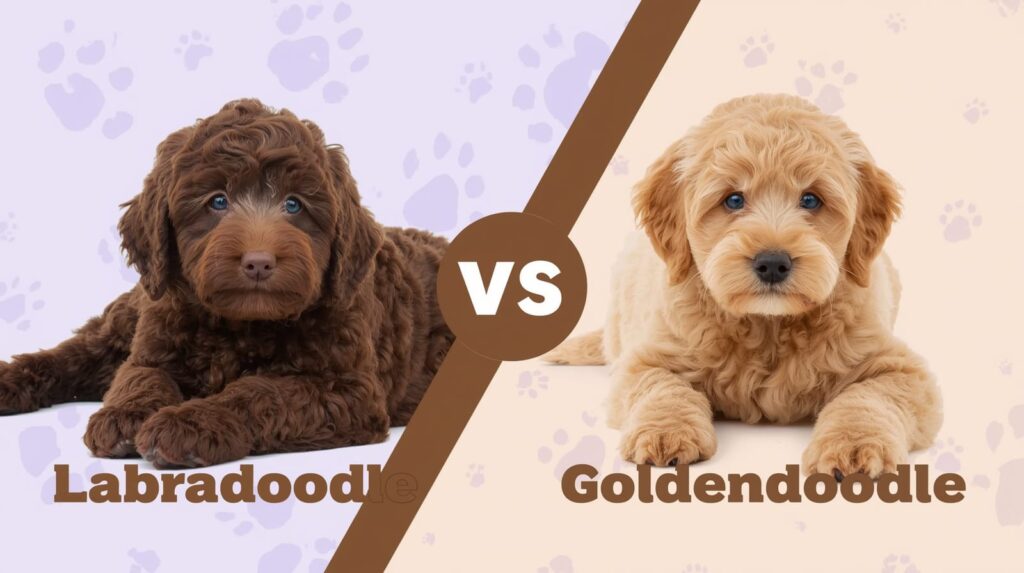Labradoodle vs Goldendoodle: Which Doodle Is Right for You?

When I first walked into the dog park five years ago, I was immediately surrounded by fluffy, friendly dogs that all seemed to look remarkably similar. “Is that a Goldendoodle or Labradoodle?” became my most-asked question. If you’re trying to decide between these two beloved designer breeds, you’re not alone and I’m here to help you make the right choice.
The labradoodle vs goldendoodle debate has dominated dog ownership discussions for years, and for good reason. Both crossbreeds have captured hearts worldwide with their teddy bear appearances, intelligent personalities, and hypoallergenic coats. But beneath their similar exteriors lie important differences that could make or break your experience as a doodle parent.
Understanding the Doodle Phenomenon
Before diving into the labradoodle vs goldendoodle comparison, let’s understand why these designer dogs became household names. Goldendoodle popularity surged 300% between 2010-2024, with 60,000-80,000 registered annually in North America. Meanwhile, social media platforms show the hashtag Goldendoodle used three times more than Labradoodle, suggesting Goldendoodles currently lead in overall popularity.
The doodle trend began in 1988 when Australian breeder Wally Conron created the first labradoodle as a hypoallergenic guide dog. This innovation sparked a designer dog revolution that continues today. Goldendoodles emerged shortly after in the 1990s, capitalizing on the proven success of poodle crossbreeding.
Breed Origins: Where Did They Come From?
Labradoodle History and Development
Labradoodles originated in Australia in the 1980s when breeder Wally Conron crossed a Labrador Retriever with a Standard Poodle to create a hypoallergenic guide dog. The goal was noble: help a blind woman whose husband had dog allergies. The resulting labradoodle puppies combined Labrador trainability with Poodle intelligence, establishing a new standard for service dogs.
Goldendoodle History and Development
The Goldendoodle breed emerged in the 1990s in North America, combining Golden Retriever warmth with Poodle intelligence, with breeder Monica Dickens credited with naming the breed around 1992. The goldendoodle quickly gained traction as families sought friendly, low-shedding companions.
Physical Characteristics: Spotting the Differences

When comparing labradoodle vs goldendoodle appearances, several distinctive features emerge:
Size Comparison
| Feature | Labradoodle | Goldendoodle |
|---|---|---|
| Weight Range | 55–95 pounds | 50–90 pounds |
| Height Range | 21–24 inches | 20–24 inches |
| Miniature Weight | 15–30 pounds | 15–30 pounds |
| Miniature Height | Varies | 13–16 inches |
Labradoodles are slightly larger, ranging from 55-95 pounds versus Goldendoodles’ 50-90 pounds, though both breeds offer miniature varieties for apartment dwellers.
Coat Types and Colors
Labradoodles typically have short, wiry fur in colors ranging from cream, tan, and gold to chocolate and black, while Goldendoodles tend to have longer coats and come in a rainbow of hues including black, red, apricot, brown, cream, tan, and gray.
Understanding coat texture proves crucial when deciding between labradoodle and goldendoodle. Both breeds display three primary textures: curly, wavy, and straight. Goldendoodles typically develop softer, silky fur compared to Labradoodles’ coarser texture.
Temperament: The Personality Showdown
The labradoodle vs goldendoodle temperament comparison reveals fascinating distinctions. From my personal experience volunteering at a rescue shelter, I’ve noticed that Goldendoodles typically greet every person like a long-lost friend, while Labradoodles often choose one or two favorite humans and remain more reserved with strangers.
Goldendoodle Personality Traits
Goldendoodles are characterized as having a cheerful personality with teddy bear looks, and they’re like the high school senior class personality or class clown always back-slapping, telling jokes, and the life of the party. They excel as therapy dogs in nursing homes, hospitals, and schools because of their naturally outgoing temperament.
Goldendoodles tend to make friends easier and faster than Labradoodles, and neither are suited to serve as any type of guard dog due to their overly friendly demeanor.
Labradoodle Personality Traits
Labradoodles are described as being like your high school senior class president confident, dependable, and loving to have a task to handle. They bring strong working drive from their Labrador genes, making them excellent service dogs for seeing-eye work and wheelchair assistance.
Labradoodles are a bit more reserved than Goldendoodles but in a loyal way, and they’re less likely to make as many new friends but are extremely loyal to their families.
Energy Levels and Exercise Requirements
The labradoodle vs goldendoodle energy comparison significantly impacts daily care routines. Labradoodles bring higher energy and working drive from their Labrador genes, requiring 60-90 minutes of daily activity, while Goldendoodles inherited the Golden Retriever’s calmer nature with less demanding exercise needs.
For active families who enjoy hiking, running, or outdoor adventures, labradoodle energy levels might align perfectly. However, families preferring relaxed walks and indoor play may find goldendoodle temperaments more suitable.
Grooming and Maintenance Requirements

Both labradoodle and goldendoodle grooming demands regular attention, but differences exist:
Grooming Needs Comparison
Grooming maintenance differs significantly between breeds Goldendoodles typically need more intensive grooming with daily brushing due to their softer coats, while Labradoodles have coarser textures requiring professional grooming every 6-8 weeks.
Grooming Costs
Grooming costs range from $50 to $150 per session, with Goldendoodles often requiring more frequent appointments due to their tendency to mat. Regular home brushing reduces professional grooming frequency and keeps both labradoodle and goldendoodle coats healthy.
Health Considerations and Lifespan
When comparing labradoodle vs goldendoodle health profiles, both breeds share similar lifespans and health concerns:
Common Health Issues
Doodles may inherit conditions from both sides of their lineage, with common concerns including hip dysplasia, allergies, ear infections, and inherited issues like Addison’s disease or progressive retinal atrophy.
However, Goldendoodles show particularly impressive health statistics. A Nationwide Pet Insurance Study found that Goldendoodles are 75.0% less likely to have a claim for cancer when compared to parent breeds, the Golden Retriever and Standard Poodle.
Lifespan Expectations
Both breeds offer similar lifespans of 12-15 years, though Goldendoodles tend to be better for beginners due to their gentler, more patient temperament. Some Goldendoodles have lived up to 18 years according to Nationwide Pet Insurance studies.
Cost Analysis: Initial and Ongoing Expenses
Purchase Prices
The labradoodle vs goldendoodle cost comparison reveals interesting trends:
Labradoodles typically range from $1,000 to $3,000, while Goldendoodles can cost between $1,500 and $5,000. For a Goldendoodle puppy you can expect to pay $600-800 USD, while for a Labradoodle puppy you can expect to pay between $1,500-2,500 USD.
Ongoing Expenses
| Expense Category | Annual Cost |
|---|---|
| Healthcare | $300 – $600 |
| Grooming | $600 – $1,800 |
| Pet Insurance | $360 – $720 |
| Food | $500 – $800 |
Healthcare costs can average $300 to $600 annually, while pet insurance typically costs $30-60 monthly depending on coverage levels and location.
Training and Intelligence
Both labradoodle and goldendoodle breeds excel in training scenarios due to their Poodle heritage. Labradoodles are desirable because both parent breeds, the Labrador Retriever and Poodle, are two of the smartest dog breeds, and because of their intelligence and athleticism, this doodle mix was first created to work as service dogs.
Goldendoodles also demonstrate exceptional trainability. Their eager-to-please nature combined with high intelligence makes them ideal for first-time dog owners. For anyone interested in learning more about similar intelligent breeds, check out our comprehensive Golden retriever Guides.
Suitability for Families and Living Situations

The labradoodle vs goldendoodle family compatibility question depends on household dynamics:
Best for Families with Young Children
Many families lean toward Goldendoodles for their slightly more relaxed and patient demeanor, especially around young children. Their gentle nature reduces concerns about accidental roughhousing with toddlers.
Best for Active Adults
Labradoodles suit active individuals or couples who can dedicate time to vigorous exercise routines. Their working drive requires mental stimulation through training exercises, puzzle toys, or dog sports.
Apartment vs House Living
Miniature versions of both labradoodle and goldendoodle adapt well to apartment living, provided owners commit to daily exercise. Standard-sized dogs thrive with yard access but can adapt to smaller spaces with sufficient outdoor time.
Owner Satisfaction and Reality Check
A study of 2,191 dog owners found that doodle owners were highly satisfied with their dogs; however, more than twice as many doodle owners than owners of other groups reported that their dog’s maintenance requirements, such as their need for regular grooming, were more intensive than they had expected.
This reality check matters. Many prospective owners underestimate grooming commitments and exercise requirements. Some owners reported their dogs shed despite being told they wouldn’t, and 13.4% of doodle owners complained about health issues including allergies, stomach issues, and orthopedic problems.
Making Your Decision: Key Factors to Consider
When choosing between labradoodle vs goldendoodle, evaluate these priorities:
Choose a Labradoodle if you:
- Want a more task-oriented, working-style companion
- Have an active lifestyle with time for 60-90 minutes of daily exercise
- Prefer a dog that bonds closely with specific family members
- Need a service dog for specific assistance tasks
- Don’t mind coarser coat textures
Choose a Goldendoodle if you:
- Want an extremely social, friendly companion
- Prefer a calmer, more laid-back energy level
- Have young children requiring gentle temperaments
- Want a therapy dog for community work
- Prefer softer, silkier coat textures
Finding a Reputable Breeder
Regardless of whether you choose labradoodle or goldendoodle, finding an ethical breeder proves critical. Health testing varies by breed, with Hip and Elbow Testing and breed-specific DNA tests costing around $1,000, and adding tests for eyes, patellas, and other blood panels increasing costs to upwards of $2,000.
Look for breeders who:
- Provide complete health testing documentation
- Allow facility visits to meet parent dogs
- Offer health guarantees for puppies
- Screen potential buyers carefully
- Maintain transparent breeding practices
Conclusion
The labradoodle vs goldendoodle decision ultimately reflects your lifestyle, activity level, and personal preferences. Both breeds offer incredible companionship, intelligence, and hypoallergenic benefits. Goldendoodles lead in social friendliness and therapy work, while Labradoodles excel in service tasks and high-energy activities.
Both breeds weigh 50-95 pounds and live 12-15 years, but Goldendoodles offer broader color options and softer coats, while Labradoodles typically need more intensive grooming due to coarser textures. Understanding these nuances ensures you select the perfect doodle companion for your household.
Remember that individual personality varies within each breed. Meeting specific dogs and their parents provides the best insight into temperament. Whether you choose a labradoodle or goldendoodle, prepare for years of joy, laughter, and unconditional love from your doodle companion.
Frequently Asked Questions
Q: Are Goldendoodles or Labradoodles better for first-time dog owners?
Goldendoodles generally prove easier for first-time owners due to their calmer temperament and eager-to-please personality. Their gentler nature requires less intensive training experience, while Labradoodles’ higher energy and working drive may challenge inexperienced handlers.
Q: Which breed sheds less labradoodle or goldendoodle?
Both breeds shed minimally when properly bred with sufficient Poodle genetics. However, shedding varies by generation (F1, F1b, F2). F1b generations of both labradoodle and goldendoodle (75% Poodle, 25% Retriever) typically shed least. No dog is truly hypoallergenic, but both breeds reduce allergen exposure compared to parent breeds.
Q: Do Labradoodles or Goldendoodles cost more to maintain long-term?
Goldendoodles typically cost more for grooming due to their softer coats requiring more frequent professional attention. However, Labradoodles’ higher energy levels may increase costs for training classes, dog sports, or doggy daycare. Overall maintenance costs average similarly, ranging $2,000-$3,500 annually for either breed.
Q: Can Labradoodles and Goldendoodles live in apartments?
Yes, miniature versions of both labradoodle and goldendoodle adapt well to apartment living with proper exercise. Standard-sized dogs require more space but can thrive in apartments if owners commit to multiple daily walks and mental stimulation activities. Goldendoodles’ calmer temperament often makes apartment living easier.
Q: Which breed is better with children labradoodle or goldendoodle?
Both breeds excel with children, but Goldendoodles’ naturally patient and gentle temperament gives them a slight edge with young kids. Labradoodles’ higher energy may overwhelm toddlers, though they form incredibly loyal bonds with older children who can match their activity level. Proper socialization matters more than breed choice but are you ready to commit to training and socializing your new doodle?






